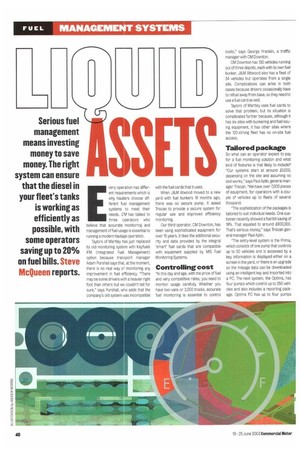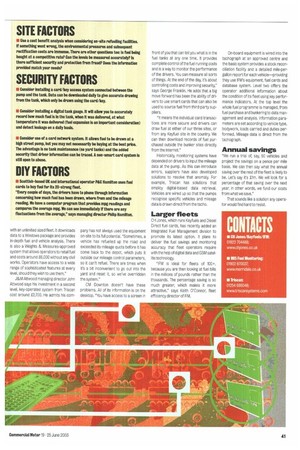;$E
Page 40

Page 41

If you've noticed an error in this article please click here to report it so we can fix it.
very operation has different requirements which is why hauliers choose different fuel management systems to meet their needs. al has talked to three cperators who believe that accurate monitoring and management of fuel usage is essential to running a modern haulage operation.
Taylors of Martley has just replaced its old monitoring systEm with Keyfuels IFM (Integrated Fuel Management) option because tramport manager Adam Purshall says that, at the moment, there is no real way o' monitoring any improvement in fuel efficiency. "There may be some drivers with a heavier right foot than others but we couldn't tell for sure," says Purshall, who adds that the company's old system was incompatible with the fuel cards that it used.
When J&M Atwood moved to a new yard with fuel bunkers 18 months ago, there was no secure pump. It asked Triscan to provide a secure system for regular use and improved efficiency monitoring.
Our third operator, CM Downton, has been using sophisticated equipment for over 15 years. It likes the additional security and data provided by the integral 'smart' fuel cards that are compatible with equipment supplied by MIS Fuel Monitoring Systems.
Controlling cost
"In this day and age, with the price of fuel and very competitive rates, you need to monitor usage carefully. Whether you have two vans or 2,000 trucks, accurate fuel monitoring is essential to control costs," says George Franklin, a traffic manager with CM Downton.
CM Downton has 130 vehicles running out of three depots, each with its own fuel bunker. J&M Attwood also has a fleet of 34 vehicles but operates from a single site. Complications can arise in both cases because drivers occasionally have to refuel away from base, so they need to use a fuel card as well.
Taylors of Martley uses fuel cards to solve that problem, but its situation is complicated further because, atthough it has six sites with bunkering and fuel issuing equipment, it has other sites where the 120-strong fleet has no on-site fuel access.
Tailored package
So what can an operator expect to pay for a fuel monitoring solution and what kind of features is that likely to include? "Our systems start at around £1,000, depending on the site and assuming no civil works," says Paul Aplin, general manager Triscan. "We have over 7,000 pieces of equipment, for operators with a couple of vehicles up to fleets of several thousand.
"The sophistication of the packages is tailored to suit individual needs. One customer recently showed a fuel bill saving of 19%. That equated to around £800,000. That's serious money," says Triscan general manager Paul Aplin.
"The entry-level system is the Prima, which consists of one pump that controls up to 50 vehicles and is accessed by a key. Information is displayed either on a screen in the yard, or there is an upgrade so the mileage data can be downloaded using an intelligent key and imported into a PC. The next system, the Optima, has four pumps which control up to 250 vehicles and also includes a reporting package. Optima PC has up to four pumps with an unlimited sized fleet. It downloads data to a Windows package and provides in-depth fuel and vehicle analysis. There is also a Weights & Measures-approved system that allows operators to retail fuel and costs around £6,000 without any civil works. Operators have access to a wide range of sophisticated features at every level, should they wish to use them."
J&M Attwood managing director John Attwood says his investment in a second level, key-operated system from Triscan cost around 12,700. He admits his corn
pany has not always used the equipment on-site to its full potential. "Sometimes, a vehicle has refuelled up the road and exceeded its mileage quota before it has come back to the depot, which puts it outside our mileage control parameters, so it can't refuel. There are times when it's a bit inconvenient to go out into the yard and reset it, so we've overridden the system."
CM Dovvnton doesn't have these problems. All of its information is on the desktop. "'You have access to a screen in front of you that can tell you what is in the fuel tanks at any one time. It provides complete control of the fuel running costs and is a way to monitor the performance of the drivers. You can measure all sorts of things. At the end of the day, it's about controlling costs and improving security," says George Franklin. He adds that a big move forward has been the ability of drivers to use smart cards that can also be used to source fuel from third-party suppliers.
"It means the individual card transactions are more secure and drivers can draw fuel at either of our three sites, or from any Keyfuel site in the country. We can then download records of fuel purchased outside the bunker sites directly from the Internet."
Historically, monitoring systems have depended on drivers to input the mileage data at the pump. As this can introduce errors, suppliers have also developed solutions to resolve that anomaly. For example, Triscan has solutions that employ digital-based data retrieval. Vehicles are wired up so that the pumps recognise specific vehicles and mileage data is drawn direct from the tacho.
Larger fleets
CH Jones, which runs Keyfuels and Diesel Direct fuel cards, has recently added an Integrated Fuel Management division to promote its latest option. It plans to deliver the fuel savings and monitoring accuracy that fleet operators require with the help of digital data and GSM satellite technology.
“IFM is ideal for fleets of 100+, because you are then looking at fuel bills in the millions of pounds rather than the thousands. The percentage saving is so much greater, which makes it more attractive," says Keith O'Connor, fleet efficiency director of FM, On-board equipment is wired into the tachograph at an approved centre and the basic system provides a stock reconciliation facility and a detailed mile-pergallon report for each vehicle—providing they use IFM's equipment, fuel cards and database system. Level two offers the operator additional information about the condition of its fleet using key performance indicators. At the top level the whole fuel programme is managed, from fuel purchase and bunkering to data management and analysis. Information parameters are set according to vehicle type, bodywork, loads carried and duties performed. Mileage data is direct from the tachograph.
Annual savings
"We run a trial of, say, 50 vehicles and project the savings on a pence per Mile basis, We can then say what the annual saving over the rest of the fleet is likely to be. Let's say it's Dm. We will look for a percentage of that saving over the next year. In other words, we fund our costs from what we save."
That sounds like a solution any operator would find hard to resist.














































































































































































